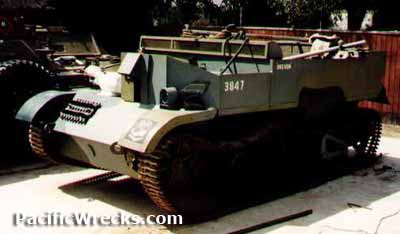Universal Carrier / Bren Gun Carrier
Technical Information
 The Universal Carrier / Bren Gun Carrier was a tracked vehicle with an open top. Designed and built by Vickers-Armstrongs, it was based on the earlier Carden Loyd tankettes including the Mark VI tankette. The carrier was designed to transport personnel, equipment or mount a support weapon or be used as a mobile machine gun. Often called a Bren Gun Carrier for the main armament of a single Bren Light Machine gun. The Universal Carrier / Bren Gun Carrier was a tracked vehicle with an open top. Designed and built by Vickers-Armstrongs, it was based on the earlier Carden Loyd tankettes including the Mark VI tankette. The carrier was designed to transport personnel, equipment or mount a support weapon or be used as a mobile machine gun. Often called a Bren Gun Carrier for the main armament of a single Bren Light Machine gun.
Australia
There were five main models built in Australia for the Australian Army. The five models were the LP1, LP2, LP2A, 2 Pounder Tank Attack and 3" Mortar Carrier. In Australia, most were used for training and in combat in the Middle East, Singapore and New Guinea. Postwar, used in Japan and Korea. Both the Local Pattern 1 (LP1) and Local Pattern 2 (LP2) series of Carriers were used by Australian Army in World War II in the Middle East, North Africa, and the Pacific including Singapore, Netherlands East Indies (NEI) and New Guinea.
New Zealand
During 1943, the New Zeland Army sent thirteen Bren Gun carriers to the Solomon Islands.
Carrier, Universal, T16
In American service, designated as Carrier, Universal, T16. During 1942 used for experimentation for potential use in the Pacific War. It was an improved version based model built by Ford of Canada with an extra road wheel on the rear bogie for a pair of Horstmann dual-wheel suspension units per side with track-break steering. Powered by an American Mercury Division 239 version (GAU370), a version of the Ford V8 engine. Built by Ford USA under Lend Lease between March 1943 until 1945. The British imported over 3,200 but it was considered mechanically unreliable and had less cargo capacity than the British Universal Carrier. Primary, used by the Canadian Army as an artillery tractor. Postwar, exported to Argentina, Switzerland and the Netherlands.
LP1
LP1 was the first unit manufactured. They were tiller steer, controlled by operating a pair of levers connected to the braking system. Powered by a Ford V8 side valve engine of 95 horsepower driving through a standard Ford four speed truck transmission to a Ford diff with a ratio of 5.83:1. However these units were found to be difficult to handle where a road only took a gentle but sweeping turn. All 160 units were built by the Victorian Railway Workshops in Newport.
Local Pattern 2 (LP2)
Australian built machine gun carrier. Bren Gun Carriers were allocated to all types of Australian Army Units. Within the Armoured Corp, they were used by a number of units. Owing to the shortage of tanks, in the newly formed 1st Australian Armoured Division on July 1, 194 a great number of Carriers were pressed into service to provide tactical training for tank crews in Milne Bay and Cape Endaiadere near Buna, where their attack failed with all five attacking Brens destroyed on December 5, 1942.
LP2A
Improvements were made and LP2 was designed. With more improved hull design which included fully welding the hull for better strength. Still powered by the same engine and transmission setup, until changes were made by Ford for the fitment of the rear axle and the model LP2A was designated. The later also having a diff ration of 6.66:1. Of this unit some 5000 were manufactured by five manufacturers 1 Victorian Railways at the Newport Workshops, 2 South Australian Railways at the Islington Workshops, 3 Metropolitan Gas Company, Fitzroy, Victoria, 4 Ford Motor Company, Broadmeadows NSW, and 5 State Engineering Works, North Freemantle, WA. The later only building 100 units upon cessation of manufacture by all other builders.
2 Pounder Tank Attack
The Tank-Attack or 2 Pounder carrier was built by the Metro Gas Co, to fill a gap as self-propelled artillery in the Anti-Tank role. Only 200 of these where built. The engine being relocated to the front left of the vehicle ( a position usually reserved for the main armament of these type of vehicles, The Bren ). This allowed for the fitment of the 2 Pounder Anti-Tank gun, firing a projectile not too dissimilar to a Bofors 40mm Anti-Aircraft round.
3" Mortar Carrier
The final was the manufacture of 400 3" Mortar carrying Carriers based on the 2 pounder hull, but with the mortar in place of the Anti-Tank gun. Also built by Metro Gas Co. all of these were given to China and not one of this model is known to be in existence today.
Production
The first
carriers were built in 1934 in the United Kingdom by Aveling and Porter, Bedford Vehicles, Ford of Britain, Morris Motors Limited, the Sentinel Waggon Works, and the Thornycroft company. When the Universal was introduced, built by by Aveling-Barford, Ford, Sentinel, Thornycroft, and Wolseley Motors. In Canada built by Ford Motor Company (Canada). In the United States built by Ford Motor Company (USA) as T16. Also built in Australia and New Zealand. By 1945, roughly 57,000 were built of all models and continued to be built until 1960.
References
Thanks to Pedr Horley for additional information.
Pedr Horley adds:
"Australian Military Equipment Profiles, Volume 2 Local Pattern Machine Gun Carriers" by Michael K Cecil is a fantastic resource on this topic or if you want more detail on the overseas built variants I suggest "Universal Carriers Volume 1" by Nigel Watson."
Technical Details
Crew 2-5
Engine Ford V8 water-cooled engine
Max Speed 50 kmp
Range 256 km
Armor 12mm
Armament 1 x Bren Gun or Boys .55 caliber anti-tank rifle
|